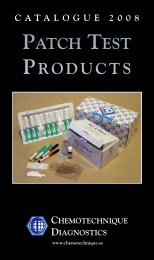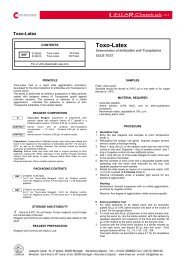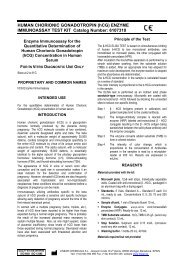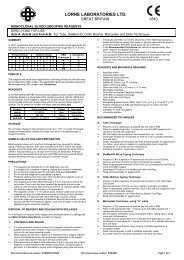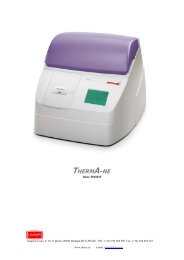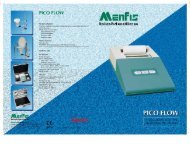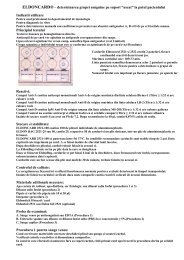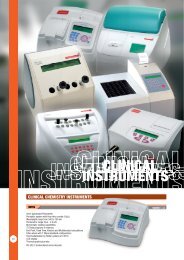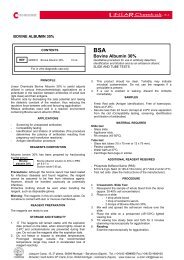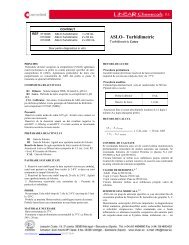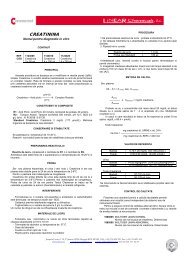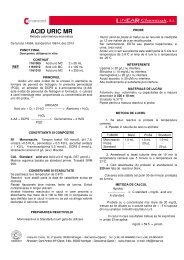Febrile Serodiagnostic - Balmed
Febrile Serodiagnostic - Balmed
Febrile Serodiagnostic - Balmed
You also want an ePaper? Increase the reach of your titles
YUMPU automatically turns print PDFs into web optimized ePapers that Google loves.
<strong>Febrile</strong> AntigensCONTENTSReagents for the determination of antibodiesagainst febrile antigens<strong>Febrile</strong> <strong>Serodiagnostic</strong>Bacterial suspensionsTUBE TESTFor in vitro diagnostic use onlyPRINCIPLEThe CROMATEST bacterial suspensions are prepared specificallyto detect, identify and quantitate serum agglutinins developedduring some febrile infections such as brucellosis, salmonellosisand certain rickettsiosis 1-3 .The suspensions have been stained (somatic in blue and flagellarin red) or have colorless presentation for some specific antigens(Note 1).The tube agglutination is carried out by preparing two-fold dilutionsof serum in saline solution and then an equal volume ofstandardized antigenic suspension. After incubation the highestdilution of the serum that causes agglutination in the presence ofthe specific antigen is determined.The tube test is considered a reference method 4-8 and as suchbecomes indispensable in clarifying equivocal agglutinations thatmay have obtained through the rapid slide test, as well as for theaccurate determination of variation in serum antibody levels thatoccur during the different stages of the infection.AgREAGENT COMPOSITION<strong>Febrile</strong> Antigen. Stabilized suspension of stained or colorlesskilled bacteria in a buffered solution. Contains 0.95 g/L ofsodium azide.CONTROL + Aglutinin-Positive. Non-titered polyvalent antiserumproduced in rabbits. Contains 0.95 g/L of sodium azide.CONTROL - Aglutinin-Negative. Non-reactive animal serum. Contains0.95 g/L of sodium azide.Warning: The reagents in this kit contain sodium azide. Do not allow tocontact with skin or mucous membranes.PACKAGING CONTENTSREF REAGENTS2101005 Brucella abortus Dil. 1 x 50 mL2103005 Brucella abortus Dil. 1 x 50 mL −colorless−2105005 Brucella melitensis Dil. 1 x 50 mL2136005 S Typhi H Dil. (Flagelar d) 1 x 50 mL2138005 S. Typhi H Dil. (Flagelar d) 1 x 50 mL −colorless−2140005 S. Typhi O Dil. (IX, XII) 1 x 50 mL2142005 S. Typhi O Dil. (IX, XII) 1 x 50 mL −colorless−2114005 S. Paratyphi AH Dil. (Flagelar a) 1 x 50 mL2116005 S. Paratyphi AH Dil. (Flagelar a) 1 x 50 mL −colorless−2118005 S. Paratyphi AO Dil. (I, II, XII) 1 x 50 mL2120005 S. Paratyphi BH Dil. (Flagelar b, 1, 2) 1 x 50 mL2122005 S. Paratyphi BH Dil. (Flagelar b, 1, 2) 1 x 50 mL −colorless−2124005 S. Paratyphi BO Dil. (IV, V, XII) 1 x 50 mL2126005 S. Paratyphi CH Dil. (Flagelar c, 1, 5) 1 x 50 mL2128005 S. Paratyphi CO Dil. (VI, VII, vi) 1 x 50 mL2108005 Proteus OX19 Dil. 1 x 50 mL2110005 Proteus OX2 Dil. 1 x 50 mL2112005 Proteus OXK Dil. 1 x 50 mL2921105 Aglutinin-Positive 1 x 1 mL2929910 Aglutinin-Negative 1 x 1 mLSTORAGE AND STABILITYStore at 2-8ºC. Do not freeze. Frozen reagents could changethe functionality of the test.Antigens and Controls are stable until the expiry date stated on thelabel.REAGENT PREPARATIONAntigens and Controls are ready to use.SAMPLESFresh, clear serum (Note 2).After the clear serum has been separated it may be stored at 2-8ºCup to one week or for longer periods at –20ºC.____1.2.MATERIAL REQUIREDTest tubes (12 x 100 mm).Automatic pipettes.Saline solution (NaCl 0.9%).Thermostatic waterbath (30-50ºC).PROCEDUREPlace 6 to 8 tubes into a rack for each antigen to be tested.Using saline solution as diluent prepare a row of two-folddilutions of the test serum as shown in the following table:Tube 1 2 3 4 5 6 7 8Saline sol. 0.95%(mL)2.3.4.Serum(µL)BacterialSuspension(mL)0.9 0.5 0.5 0.5 0.5 0.5 0.5 0.5100 −0.5 mL serial dilutions− 00.5 0.5 0.5 0.5 0.5 0.5 0.5 0.5Final dilution 1:20 1:40 1:80 1:160 1:320 1:640 1:1280 ControlAdd 0.5 mL of the appropriate bacterial suspension previouslyshaken to each tube of given row and mix (Note 3). Final serumdilutions are shown in the above table.Incubate at 37ºC in the waterbath for 24 hours, or with thesomatic tritrations at 50ºC for 4 hours and with the flagellartritrations at 50ºC for 2 hours, before reading.Examine macroscopically for agglutination.ReadingRead the results of all control tubes first. Remove 2-3 tubes ata time from the rack, hold them in front of a suitable source oflight and observe every tube for clearing of the supernatantfluid and amount and character of the sediment and agglutinateparticles. After examining the sediment pattern shake the tubegently.
Negative reaction: In the antigen control and negative reactionthe appearance of the suspension should be unchanged, andshow a typical swirl when the tube is flicked.Positive reaction: In a positive reaction there is an obviousagglutination and a variable degree of clearing of thesupernatant fluid.Flagellar agglutinins (H) produce large floccular aggregateswhich are easily broken up, whereas somatic agglutinins (O)produce granular or small flaky aggregates.The end point titer of the serum is designated as the highestdilution that will cause agglutination of a known bacterialantigen. The next dilution should be negative.QUALITY CONTROLPositive and negative serums as well as Suspension Control tubesshould be run daily to check the operativity of the system.EXPECTED VALUESSalmonella and Brucella: Titers greater than 1/80 (somatic andbrucella antigens) and 1/160 (flagellar antigens) indicates recentinfection.Proteus: Titer of less than 1/160 should not be consideredsignificant.A single positive result has less clinical significance than thedemonstration of a rising or decreasing titre between successiveserum specimens taken days apart.CLINICAL SIGNIFICANCE<strong>Febrile</strong> Antigen is a term which has been accepted generally asreferring to bacterial suspensions representative of a number ofpathogenic microorganisms to human, involved in some bacterialinfections (brucellosis, salmonellosis and certain rickettsiosis) whichare accompanied by a fever in the host. The best option to establishthe etiology of an infectious disease is by isolation and identificationof the causative agent. However, these culture techniques may bedifficult to use and the febrile serodiagnostic tests becomeimportant to detect the antibodies produced in the patient serumduring the infection (indirect method of diagnosis).Testing <strong>Febrile</strong> Antigens has a high diagnostic value as theirexclusion or detection can support or place doubt on a tentativediagnosis made on the basis of case history data and clinicalfindings.____ANALYTICAL PROCEDUREThere is not a Reference Material for the sensitivitystandardization of these reagents. For this reason, LinearChemicals adjust the sensitivity of their reagents against tospecific antisera and commercial reagents of certified quality.Prozone effect: False negative results may be obtained with seracontaining a high titer of antibodies. A dilution of these sera willgive a positive result.Results obtained with this reagent did not show significativedifferences when compared with reference reagents. Details ofthe comparison experiments are available on request.Hemoglobin (



